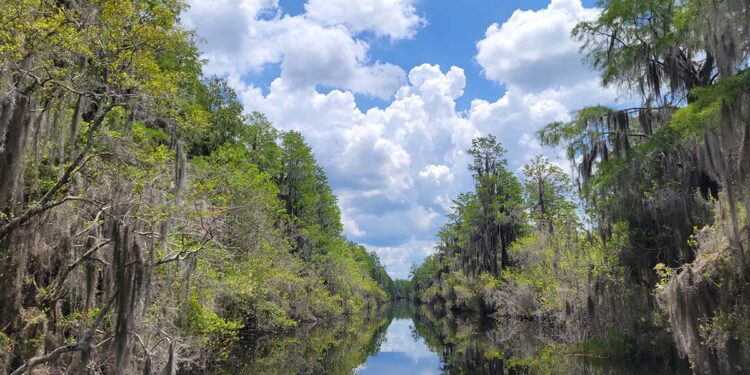Byline: Braden Harper/Reporter
OKMULGEE, Oklahoma – The Okefenokee Swamp has been described as “the most blissful spot of the earth,” according to 1700s Author William Bartram. The Muscogee (Creek) Nation is doing everything within its power to preserve that title as the fight for preservation continues.
Turner Hunt, Archeological Technician for MCN Historic & Cultural Preservation, is at the forefront of the fight.
“We have a shared history. There are signatories on many of the Creek Nation treaties. From that, we have those Creek contact ties,” Hunt said.
Hunt and MCN NAGPRA Coordinator Emman Spain recently surveyed the Okefenokee Refuge. Their original purpose in traveling southeast was reburials, something they had not been able to do because of the COVID-19 Pandemic.
Over the past two centuries, the swamp’s natural resources have attracted the attention of outside entities wanting to develop the area. The most recent bid to propose plans for the site comes from Twin Pines Minerals LLC.
According to critics, the company has made headlines for proposing a titanium mine on 740 acres, a proposal that could threaten the ecosystem.
“Potentially what you’re looking at as someone coming in and breaking those hard pack layers down to a level that would allow the water to percolate through,” Hunt said. “And that is what can cause some very large environmental and cultural concerns.”
According to Hunt, if the water levels in the drier areas of the swamp drop by even a half inch due to a man-made development, it could leave the area prone to fires.
A recent move by the Biden Administration reversed a decision made during the previous administration era regarding the federal government’s power to approve project developments to the swamp. This means that new development plans would have a higher bar of comprehensive review by the Army Corp. of Engineers before approval.
This includes appropriately consulting tribes that hold cultural and historical significance to Okefenokee, like MCN. The federal government refers to MCN’s connections as “prehistoric.” The tribe simply refers to it as history.
Twin Pines’ response to the block came from a lawsuit against the Army Corp of Engineers. They allege that the proposed mine is a safe distance away that would not affect the swamp.
The area has been sought after for development due to the naturally occurring titanium dioxide. It is a resource that is commonly used in cosmetics, food, and paints. “Once you mine it, you almost have guaranteed sellers within the U.S Government,” Hunt said. “There’s always that desire to go in there and harvest it.”
The swamp has special meaning to the Muscogee (Creek) Nation and other tribes from the area. It’s been called by different names, including Onoquaphenogaw and Akefonogo.
The cultural consequences could be irrevocable if the swamp falls victim to development. According to Hunt, it is very possible that Okefenokee could contain water graves like Windover Pond, found just under 200 miles south in Titusville.
“Even though there’s plenty of known cultural sites above ground that could be impacted, there is potential for many, many known cultural sites or cemeteries that would only be discovered through the destruction of the swamp,” Hunt said.
MCN Historic and Cultural Preservation has worked closely with the U.S. Fish and Wildlife to ensure the swamp is properly protected. There are also plans to push for a tribal resolution through the MCN National Council to reiterate Okefenokee as a traditional cultural property.
The site currently sits on the tentative list of the United Nations Educational, Scientific, and Cultural Organization World Heritage Convention.
While the fight for preservation continues, awareness is another weapon conservationists use to combat the threat of land development.
Hunt’s trip inspired him to bring others out to Georgia to share the same experience.
“My immediate thought was, how can I get more Muscogee Citizens to come out here and see this?” Hunt said.
According to Hunt, awareness of the site’s historical significance to the Muscogee Nation is crucial for its survival as a refuge. The goal is to be able to bring a group of citizens to see the swamp.
“We want to preserve these sights, and we want more citizens,” Hunt said. “When our crew returns, they tell more people how beautiful it is.”
To learn more about the Muscogee Nation’s Cultural Preservation efforts see previous coverage here.





